The Microsoft Surface Book 2 (15-Inch) Review: Second Time's The Charm
by Brett Howse on December 21, 2017 8:00 AM EST- Posted in
- Laptops
- Microsoft
- Surface
- Pascal
- Surface Book
- Kaby Lake Refresh
Display Analysis
One area where Microsoft has consistently outperformed the competition is in the display department. They continue to be the only major PC maker to hardware calibrate their displays at the factory, across the entire product lineup. It wasn’t always the case, but starting with the Surface 3, all Surface devices are now calibrated, and the Surface Book 2 is of course no exception.
The benefit of a hardware calibration over something you could do on your own is that you avoid issues with clipping the display to correct issues, and of course the other benefit is the display is the right color without any work involved by the end user.
For the Surface Book 2, the 13.5-inch model keeps the same 3000x2000 3:2 aspect ratio display as the original, and that’s not a bad thing, since it was arguably the best display we’ve tested in a notebook to date. For the larger 15-inch model, the aspect ratio stays the same, but you get a few more pixels at 3240x2160. The overall density is slightly less than the smaller Book, but the difference is small. The 13.5-inch model is 267 PPI, and the 15-inch model is 258 PPI.
Microsoft also has started to add some rudimentary color management tools for the end user, with selectable color profiles in the action center. They started this trend with the Surface Studio, which is the only Surface model to date which supports the wider color gamut of DCI-P3 and P3-D65, but it also has a profile for sRGB, which is what most of the web and applications use. While it would be nice to see P3-D65 gamut support on the other Surface devices as well, there are power implications of wider gamut LEDs, and the lack of a true color management system in Windows means it’s generally best to leave the system in sRGB mode anyway.
With both the new Surface Pro, and the Surface Book, to offer some of the P3-D65 benefits but with the constraints of a sRGB panel, Microsoft provides an Enhanced mode which offer mid-tones closer to P3-D65 without affecting skin tones. That gives you a bit more pop in the colors without blowing out skin tones, and is the default color mode on the Surface Book 2. It’s not the same as a true P3-D65 display by any means, but for people who feel sRGB is a bit too dull for them, it’s a way to keep those users happy as well.
To look at the Surface Book 2’s display characteristics, we utilize SpectraCal’s CalMAN suite, along with an X-Rite i1DisplayPro colorimeter for contrast and brightness readings, and the X-Rite i1Pro2 spectrophotometer for color accuracy.
Brightness and Contrast
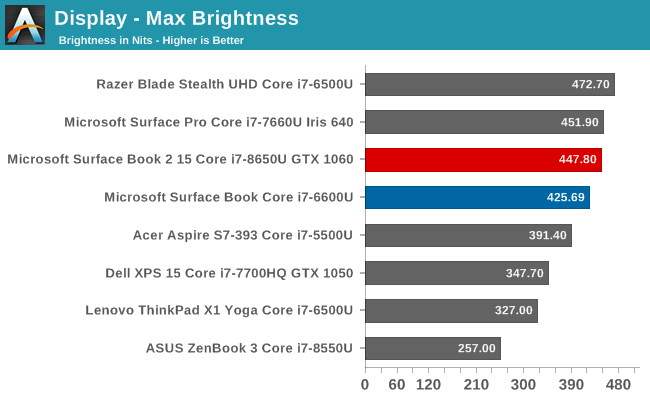
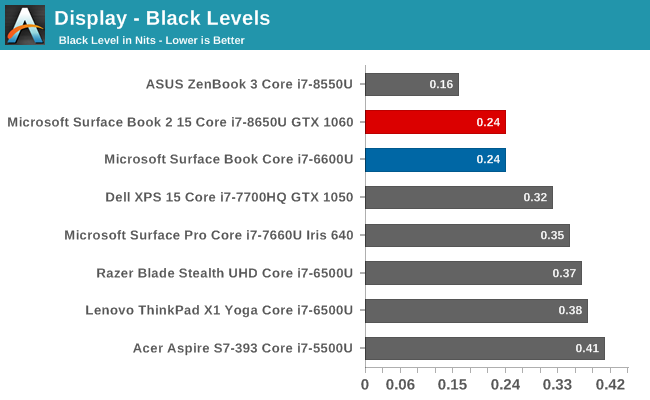
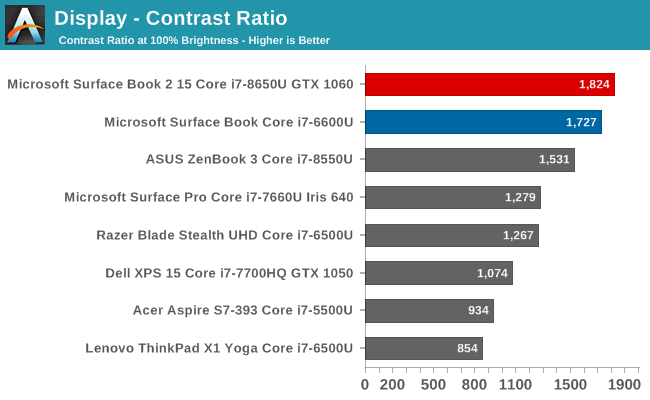
The larger Surface Book 2 gets plenty bright, and about 450 nits, which will help if using in a bright environment or outside. But despite these very bright whites, the black levels are still very solid, leading to excellent contrast. This was one of the best things about the original Surface Book, and the black levels really help out in video content.
For those that want to use the Surface Book 2 in a dim room, the display goes all the way down to 4 nits, so there is plenty of brightness range to find a level suitable for anyone.
Grayscale

Thanks to the factory calibration, the Surface Book 2 offers exceptional grayscale results. The overall dE2000 is by far the best we’ve ever tested. The gamma levels stay pretty close to the 2.2 level, as they should. Unlike some devices where great grayscale on the black levels helps drive the average down for poor grayscale at 100% white, the Surface Book 2 is almost perfect across the entire range, with no level exceeding a dE2000 of 2.0. The white point is perfect as well.
Gamut
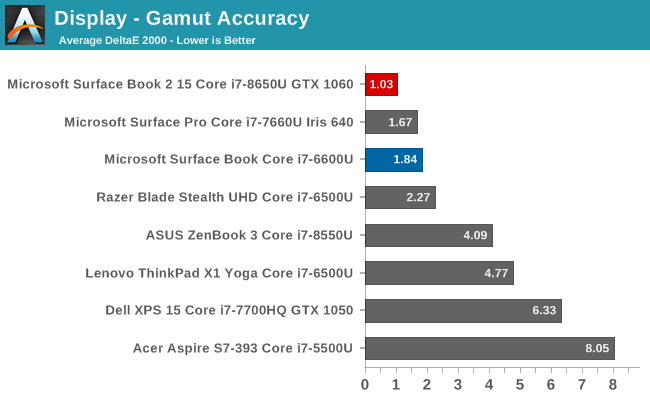
The gamut results mirror the grayscale, in that they are almost perfect for both the primary and secondary colors. Only 100% blue is slightly off, which drags cyan off a bit as well, but the error levels are so small it would be difficult to detect them with the human eye.
Saturation
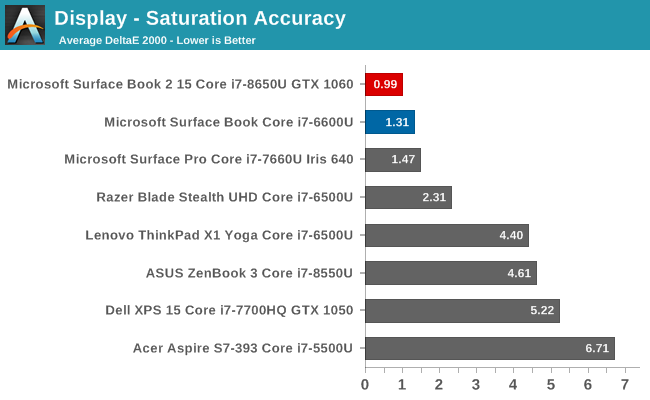
Rather than just test the 20% levels, we now do a full 4-bit step for saturation. The Surface Book 2 has an overall dE2000 level under 1 for this test, which is exceptional.
Gretag Macbeth
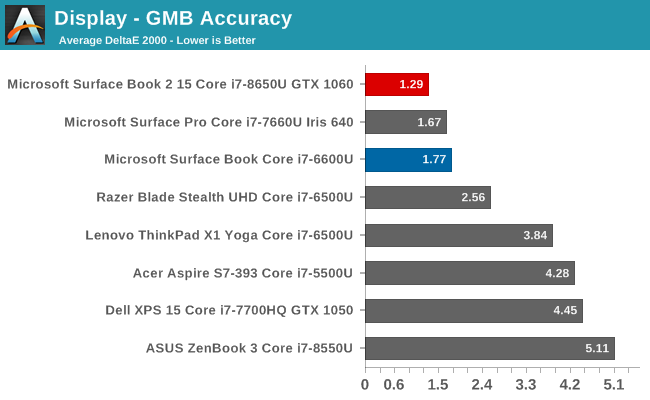
The Gretag Macbeth test covers far more colors, and is the most comprehensive test. It includes the important skin tones as well. The overall result for the Surface Book 2 is once again, fantastic. A few colors drift slightly, but very few even creep over the 2.0 error level.
In addition, we run a colorchecker test to provide a relative comparison of the correct color that should be displayed on the bottom, along with the color that is actually displayed on top. The result is relative though due to error levels in your own display, but you can see that the Surface Book 2 has white and color levels that are nearly perfect.
Enhanced Mode
Turning on Enhanced Mode changes the gamma and uses hardware to shift the colors for some colors, without affecting the skin tones.
You can see the gamma is off quite a bit compared to the 2.2 level it should hit, compared to the nearly perfect gamma in sRGB mode. The overall grayscale levels are still far better than practically any other notebook though.
The Gretag Macbeth shows off the effect on colors. The dE2000 level is much higher on certain colors, but the skin tones remain unchanged. But even so, with a GMB result under 2.0, even in enhanced mode the color accuracy is far better than almost any other notebook.
Display Conclusion
Microsoft continues to be the only major PC maker to color calibrate all of their devices, and the Surface Book 2 sets new levels for accuracy in a notebook. The display also has amazing contrast. It’s not difficult to add these together and say that the Surface Book 2 has the best display on any laptop.


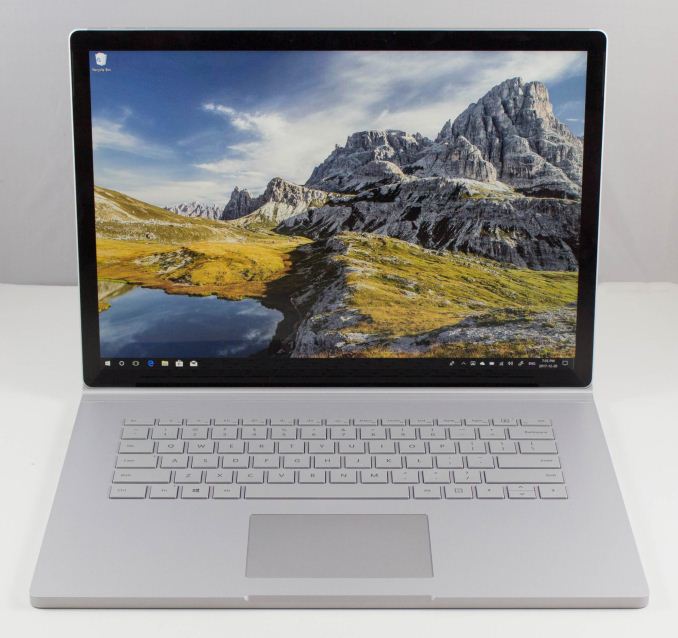
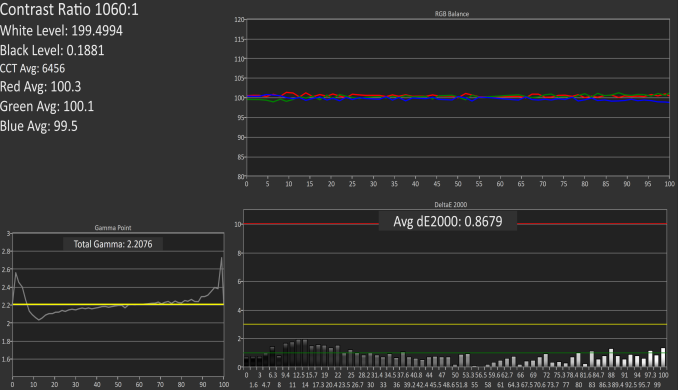

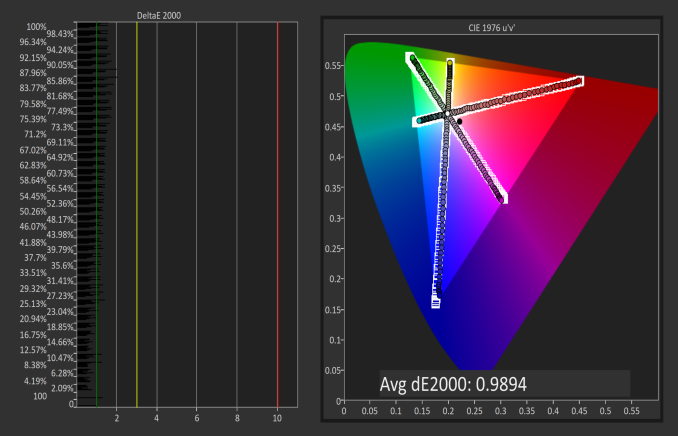



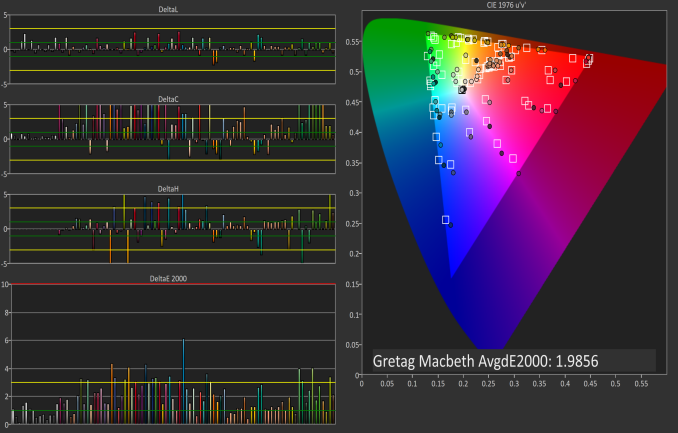








120 Comments
View All Comments
gentryfunk22 - Sunday, December 31, 2017 - link
My partner just received this device as her main laptop at work. The Surface 2 replaced a MacBook Air. Her main complaint is the trackpad. It is terrible. Does not track well, the hotspots work inconsistently, and clicks are not recognized. Use as a tablet drains the battery much faster than is found in this article...in fact, during a conference call last week, she got about 90 minutes of use from full charge in tablet mode. FYIajay92 - Monday, January 1, 2018 - link
Seems like it will get too hot too fastYaronGo - Monday, January 15, 2018 - link
Buyer beware: System stability is a big issue with Gen1. Does Gen2 solve this?I bought the first generation the month it came out, and to date it is suffering from instability (not as many daily BSODs thank god - the first year was a nightmare!). WiFi doesn't connect to all networks, sometimes requiring reboot. Sometimes it goes into tablet mode thinking it's in that mode and not letting you use the keyboard/mouse, and that's just two I have issues with daily. Then there's battery drain (3 hours some days) and problems going into hibernation (yeah, it's fun to lose all your work!).
I'd be very wary of buying an expensive laptop like this. Wait till you get some reviews after 3 months of daily use. Check out Gen1 reviews/forums for reference.
damianrobertjones - Thursday, October 11, 2018 - link
...and the biggest question is: Why didn't you get it replaced? We have 3 SBooks in work. So far all have been fine.Timur Born - Wednesday, January 24, 2018 - link
All USB ports are still connected to a subpar Genesys Logic USB hub chipset instead of being directly connected to the Intel chipset. This was a problem with version 1 and remains to be a problem with version 2. It's a slightly improved new chipset, though. Still an unnecessary solution, only meant to lower production cost instead of improving user experience.damianrobertjones - Thursday, October 11, 2018 - link
...and the general user experience will be the same as no-one will notice.Chris_outwright - Thursday, April 12, 2018 - link
Cinebench R15 and with SB2 15" you get over 600 or 700 Points. This is Bull S*. I got between 500-600. Either your device is rigged or you got absolutely the best out of the Silicon Lottery, and I the worst!winndzn02 - Sunday, May 13, 2018 - link
My surface book 2 15 is only getting 5000-6000 firestrike test results. That is so much lower than what you are getting. Would you have any idea why this would be? Id love some help from anyone here!WindowsXp16 - Tuesday, January 15, 2019 - link
Brett Howse - Whats your max CPU temp. I recently got the 15" Surface Book 2 and my temps using cinebench reach up to 90 plus degrees Celsius. I am trying to figure out if this is normal so i can decide weather to exchange my unit or not